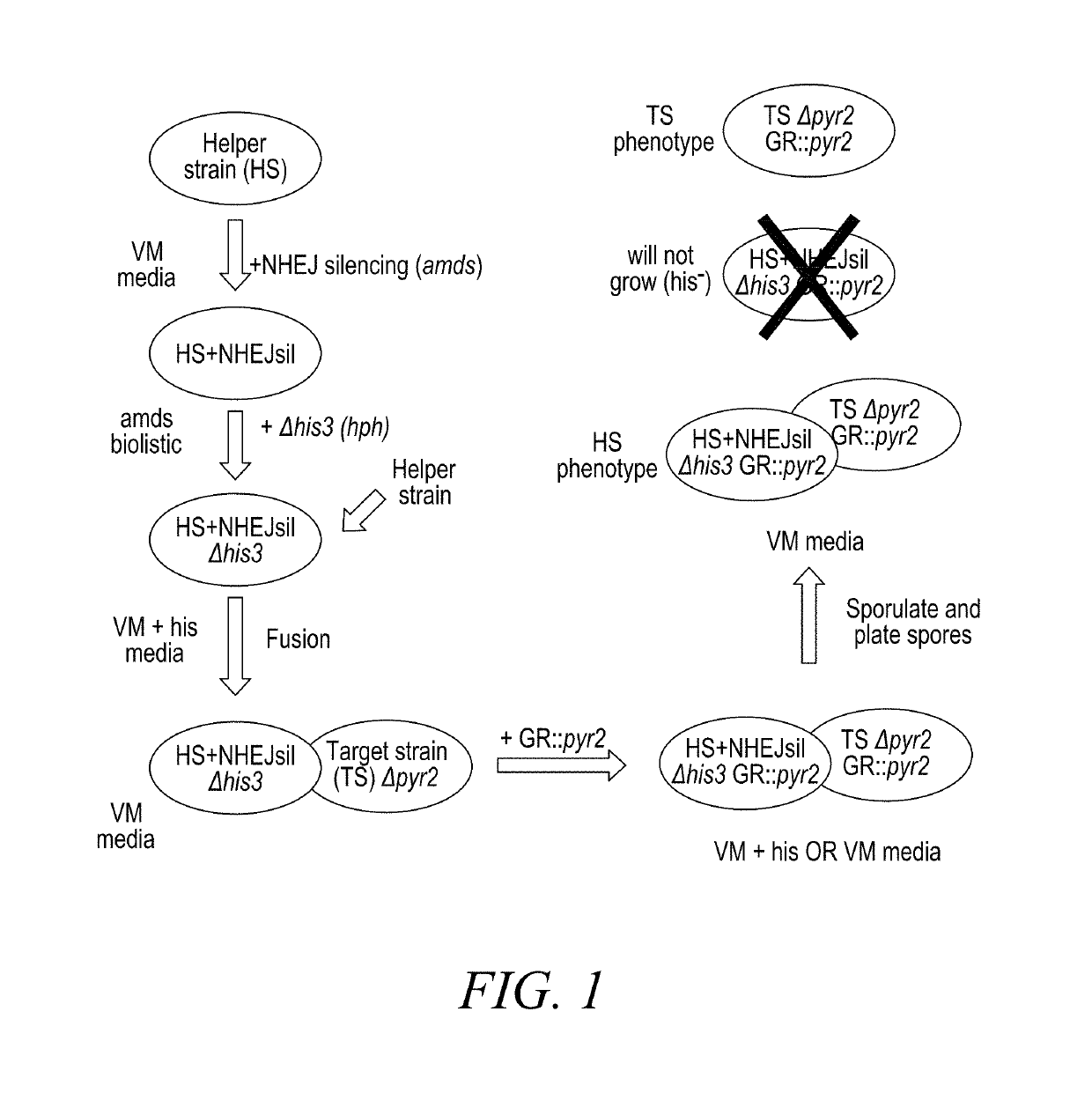Compositions and methods for helper strain-mediated fungal genome modification
a technology of fungal genome and strain, applied in the field of compositions and methods for helping strain-mediated fungal genome modification, can solve the problem that the concept of helping strain has not been incorporated into the routine manipulation method
- Summary
- Abstract
- Description
- Claims
- Application Information
AI Technical Summary
Benefits of technology
Problems solved by technology
Method used
Image
Examples
example 1
Use of Helper Strain for Complementing Colonial Growth and Determining Allele Dominance
[0167]Experiments were performed to use a helper strain for complementing colonial growth and determining allele dominance. The work flow and the result of one of such experiments are shown in FIG. 7. Steps of this experiment include:
[0168]1) Fusing helper strain (HS) and target strain (CS, or Colonial Strain in FIG. 7) to form a heterokaryon;
[0169]2) Generating conidiospores from the heterokaryon;
[0170]3) Harvesting the conidiospores and diluting to appropriate concentration;
[0171]4) Plating conidiospores on selective media and counting colonies to score the phenotype and auxotrophy; and
[0172]5) Confirming the strains obtained.
[0173]In this particular experiment the helper strain (HS) is a RL-P37 Δcbh1 Δcbh2 Δegl1 Δegl2 Δhis3 strain with wild type colony growth rates and conidiation, and the target colonial strain (CS) is a RL-P37 Δcbh1 Δcbh2 Δegl1 Δegl2 Δpyr2 strain with deletion of a gene of in...
example 2
Silencing of NHEJ Mechanism in Fungal Cells with DNA Constructs Constructs
[0174]The pAVTrku80sil construct for silencing ku80 (FIG. 2A) contains a sense and antisense ku80 DNA sequence interrupted with an intron sequence, and is driven by a divergent promoter. The divergent promoter also drives the expression of Ptilosarcus sp. green fluorescent protein (PtGFP), which serves as an indicator of the antisense cassette expression. The construct also contains the amdS selective marker.
[0175]The intermediate construct for silencing both ku80 and ku70 (pAVTrku70ku80sil, FIG. 2B), and another construct for silencing ku70, lig4 and ku80 (pAVTrku70lig4ku80sil, FIG. 2C) have been generated and verified. They contain approximately 500 bp sense sequences of the respective genes, an intron and the equivalent antisense sequences, followed by the ku70 terminator sequence in the yeast pRS426 vector backbone.
[0176]The gene replacement construct fragments incorporated into the pRS426 vector have been...
example 3
Use of cre Recombinase in a Helper Strain or Heterokaryon for Removal of DNA Fragments in a Target Cell
[0180]In one embodiment, a user can express cre recombinase in a helper strain and use it for removal of any DNA fragment in a target cell flanked by loxP sites.
[0181]In another embodiment, a user can introduce a telomeric vector expressing cre recombinase into a heterokaryon, and simultaneously remove one or more DNA fragments flanked by loxP sites in each of the helper and target strains. A schematic example is shown in FIG. 5. Two deletion strains, each with a deletion cassette containing the hph marker flanked by two loxP sites at the ad3A (Strain 2) or his3 (Strain 1) loci of a wild type strain, were obtained by homologous recombination. To recycle the hph marker and concurrently remove it from one or both strains, Strain 1 and Strain 2 were first fused into a forced heterokaryon using the procedure described in Example 1. The heterokaryon was then transformed with a cre-conta...
PUM
| Property | Measurement | Unit |
|---|---|---|
| Tm | aaaaa | aaaaa |
| Tm | aaaaa | aaaaa |
| Tm | aaaaa | aaaaa |
Abstract
Description
Claims
Application Information
 Login to View More
Login to View More - R&D
- Intellectual Property
- Life Sciences
- Materials
- Tech Scout
- Unparalleled Data Quality
- Higher Quality Content
- 60% Fewer Hallucinations
Browse by: Latest US Patents, China's latest patents, Technical Efficacy Thesaurus, Application Domain, Technology Topic, Popular Technical Reports.
© 2025 PatSnap. All rights reserved.Legal|Privacy policy|Modern Slavery Act Transparency Statement|Sitemap|About US| Contact US: help@patsnap.com



